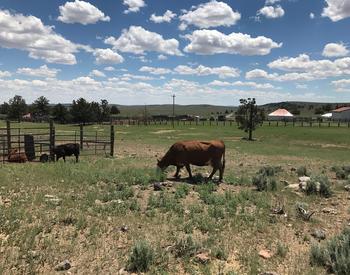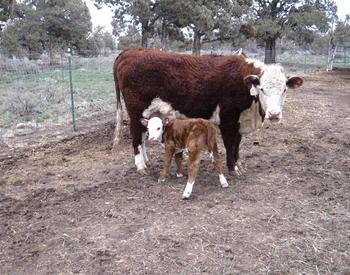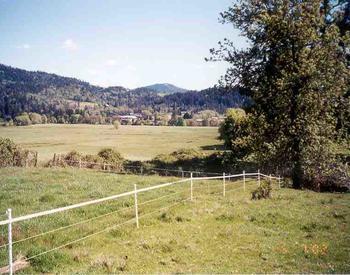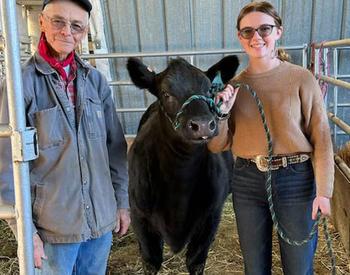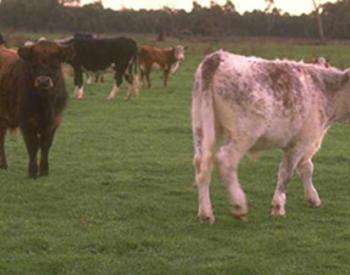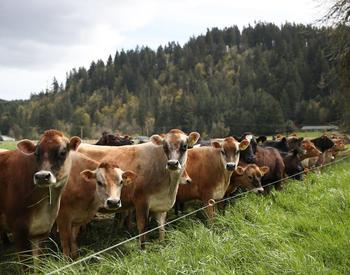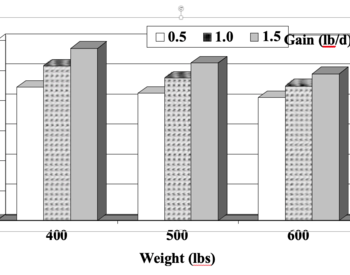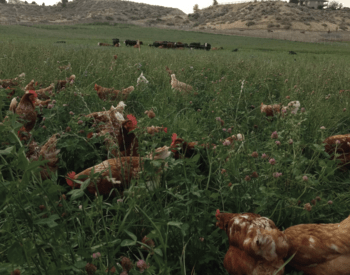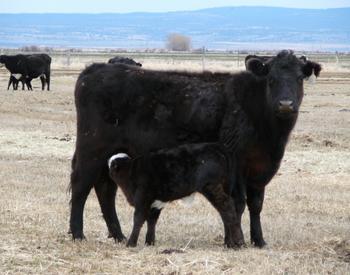Introduction
Selecting a bull is one of the most important management decisions a beef producer makes. Since it is possible for a bull to sire 25 or more calves in each calf crop, the bull has much more influence on the genetic makeup of the herd than does the individual cow. Before selecting a bull, every producer needs to establish long-term goals for the herd. The decisions made in bull selection today will be evident in the herd for years to come. Therefore, you must establish breeding goals and stick with them. A successful beef cattle breeding program is a long-term commitment with careful planning, evaluation and re-evaluation of goals and progress.
How to Use EPDs
Expected progeny differences (EPDs) were developed to aid cattle breeders in the selection of breeding stock. EPDs are of no value unless they are used to compare two or more animals or rank an animal for a trait within the breed. These values predict the performance of the offspring from an individual animal and are calculated using data from the animal, it’s ancestry and offspring, and the breed base (a group of animals, as defined by the breed association, used as a genetic reference point).
EPDs account for both genetic and environmental differences. The use of EPDs for sire selection results in a more accurate evaluation of sires over comparing actual data (which does not account for environmental differences, ancestry, or offspring).
In sire summaries, EPDs are generated for multiple traits. They are reported as either a (-) or a (+) value, meaning below or above breed base.
Remember, EPDs measure the potential difference in offspring performance of two or more sires. For example, if Bull A has a BW of -2, Bull B has a BW of +1.5, and each sire is mated to similar females; progeny from Bull A can be expected to have a BW 3.5 lbs (1.5 - (-2) = 3.5) lighter than Bull
B. Likewise, if Bull A has a YW of +70 and Bull B has a YW of +40; progeny of Bull A can be expected to have a YW that is 30 lbs (70 - 40 = 30) heavier than progeny of Bull B.
Producers can compare sires within a breed against the average performance of all sires in the breed registry by looking at the percentile rank.
Many associations report sires as top 10%, top 20%, bottom 10%, bottom 20%, and so on. Rank will change often as sires are added to the registry on a regular basis. Breed averages are not usually equal to zero and can be found in the breed association’s sire summary (Table 1)
| Production | Maternal | Carcass | |||||||||||||
|---|---|---|---|---|---|---|---|---|---|---|---|---|---|---|---|
| CED | BW | WW | YW | YH | SC | Doc | CEM | Milk | MW | MH | CW | Marb | RE | Fat | |
| Current Sites1 | 5 | 1.9 | 44 | 81 | 0.4 | 0.41 | 8 | 7 | 21 | 30 | 0.4 | 14 | 0.36 | 0.15 | 0.01 |
| Main Sites | 0 | 1.9 | 47 | 85 | 0.9 | 0.42 | 9 | 7 | 21 | 60 | 0.4 | 15 | 0.35 | 0.15 | 0.012 |
Accuracy
The accuracy of EPD values increases over time as more performance data is collected from offspring. Accuracy can range from 0.0 (no information) to 1.0 (100% accurate). However, you will not see 1.0 as we can never truly predict, with 100% accuracy, genetic merit of the animal. As accuracy nears 1.0 for a trait, the more reliable the EPD becomes at predicting the average performance of the sire’s offspring. Low accuracy increases the likelihood that EPD values will change for that individual. Accuracy values closer to 1.0 are desirable for traits that need to be closely managed. For example, calving ease (CED) may need to be closely managed if the breeder has cattle on range with minimal human oversight that must be able to deliver a calf unassisted. A sire with low accuracy for CED may have greater potential to yield offspring that will require human intervention and increased incidences of dystocia and death loss resulting in reduced profit. Table 2 demonstrates how accuracy affects the potential variation of trait values around the published EPD. For example, a bull with an accuracy of 0.10 may have 7.2% more or 7.2% fewer calves requiring assistance, than the published CED value. However, a sire with an accuracy of 0.95 has the potential to sire only 0.4% more or fewer birthing assistance than the published CED value. As illustrated, accuracy is a risk management tool. Low accuracy does not mean the sire is poor, it simply means there is greater potential that the EPD value can change. With high accuracy bulls there is less chance offspring performance will be a surprise.
| Production | Maternal | Carcass | ||||||||||||
|---|---|---|---|---|---|---|---|---|---|---|---|---|---|---|
| Accuracy | CED | BW | WW | YW | YH | SC | CEM | Milk | MW | MH | CW | Marb | RE | Fat |
| .10 | 7.2 | 2.36 | 10.4 | 15.3 | 0.39 | 0.66 | 8.8 | 8.7 | 36 | 0.58 | 17 | 0.26 | 0.29 | 0.039 |
| .50 | 3.9 | 1.31 | 5.6 | 8.5 | 0.22 | 0.37 | 4.9 | 4.9 | 20 | 0.32 | 10 | 0.15 | 0.16 | 0.022 |
| .70 | 2.4 | 0.79 | 3.5 | 5.1 | 0.13 | 0.22 | 2.9 | 2.9 | 12 | 0.19 | 6 | 0.09 | 0.10 | 0.013 |
| .80 | 1.6 | 0.53 | 2.3 | 3.4 | 0.09 | 0.15 | 2.0 | 1.9 | 8 | 0.13 | 4 | 0.06 | 0.06 | 0.009 |
| .90 | 0.8 | 0.26 | 1.2 | 1.7 | 0.04 | 0.07 | 1.0 | 1.0 | 4 | 0.06 | 2 | 0.03 | 0.03 | 0.004 |
| .95 | 0.4 | 0.13 | 0.6 | 0.9 | 0.02 | 0.04 | 0.5 | 0.5 | 2 | 0.03 | 1 | 0.01 | 0.02 | 0.002 |
Types of EPDs
There are three main categories of EPD traits: growth, reproductive, and carcass.
Types of EPDs2 :
- Growth traits
- Birth weight (BW)
- Weaning weight (WW)
- Milk (MLK)
- Yearling weight (YW)
- Mature height (MH)
- Mature weight (MW)
- Reproductive traits
- Gestation length (GL)
- Calving ease direct (CED)
- Heifer pregnancy (HP)
- Scrotal circumference (SC)
- Calving ease maternal (CEM)
- Carcass traits
- Slaughter data
- Carcass weight (CW)
- Ribeye area (REA)
- Fat thickness (FAT)
- Marbling (MARB)
- Retail product (RP)
- Yield grade (YG)
- Tenderness (WBS)
- Ultrasound
- Ribeye area (UREA)
- Fat thickness (UFAT)
- Retail product (URP)
- Percent intramuscular fat (UMARB)
- Slaughter data
An explanation of each trait can be found in the breed association sire summaries. It is important for producers to recognize how traits relate to one another. For example, if one is selecting for high yearling weights, mature size increases. If the goal is to reduce mature size of the cow herd, select bulls with lower yearling weight EPDs. . With such a wide array of traits to choose from, sire selection using EPDs can seem daunting. However, if a producer has set goals for genetic change and an understanding of how each EPD trait is derived, sire selection can be simplified.
Economically Relevant Traits vs. Indicator Traits
Genetic change typically has one goal—to improve profit. The traits that directly influence profit by affecting either income or cost of production are considered economically relevant traits (ERT). All other traits are indicator traits (Table 3). In order to determine if a trait is an indicator or ERT, one must question whether or not an increase or decrease in one unit of the EPD results in a direct change of income or cost. If it does, then the trait is an ERT; if not, it is an indicator trait. For example, a one pound increase in birth weight does not directly affect input or revenue; however, a decrease in calving ease (greater number of calves born with assistance) increases labor. Calf death loss directly influences both income and cost. Thus, Birth Weight is an indicator trait while Calving Ease is an ERT. One should use ERT for selection, when available. If indicator traits are used to calculate ERT, then the indicator trait should not be used, as it will be accounted for in the ERT.
| Economically Relevant Trait (ERT) | Indicators |
|---|---|
| Probability of Calving Ease | Calving Ease Score, Birth Weight, Gestation Length |
| Sale Weight (Weaning Direct, Weaning Maternal, Yearling Weight, Carcass Weight) | Birth Weight, 205 d Weight, 365 d Weight, Carcass Weight |
| Cow Maintenance Feed Requirement | Mature Cow Weight, Cow BCS, Milk Production, Liver, Weight, Gut Weight |
| Heifer Pregnancy Rates | Pregnancy Observations, Scrotal Circumference |
| Marbling Score (Quality Grade) | US% Intramuscular Fat, Carcass Marbling Score, Backfat Thickness |
| Retail Product Weight | Carcass Weight, Ribeye Area, Backfat Thickness |
| Docility | Docility Scores |
Direct vs. Maternal
Most EPDs predict the performance of the first generation of progeny—the sons and daughters of the sire. These are considered direct EPDs.
Maternal EPDs predict the performance of the second generation (grandchildren) birthed from the sire’s daughters. Maternal EPDs are only important if the progeny will be retained as replacement females. Milk, sometimes referred to as maternal milk or maternal milking ability, is the classic maternal EPD. Calving ease is a direct EPD (CED), reflecting the ease the sire’s calves will be born.
Maternal calving ease (CEM) is the ease at which the sire’s grandchildren will be born to the sire’s daughters.
Total maternal (TM) should not be confused with milk. Total maternal takes into account the milking ability of the daughters and the direct weaning weight passed to the daughter (½ of WW, as ½ is due to the mother and ½ is due to the genetics passed from the sire in question). The difference in TM values of two sires predicts the difference in weaning weight of the sire's grandchildren birthed from the sire's daughters. In Table 4, grandchildren from Bull A are expected to average 23 pounds heavier (32-9 = 23) than grandchildren of Bull B.
| Weaning Weight EPD | Milk EPD | Total Maternal EPD | |
|---|---|---|---|
| Bull A | +30 | +17 | +32 = 0.5(30) + 17 |
| Bull B | +10 | +4 | +9 = 0.5(10) + 4 |
Selection Index
It is not realistic to assume we can choose sires on one or two traits alone. Many times commercial operators are concerned with multiple traits. However, selecting sires for multiple traits, some of which are antagonistic to each other, has proven difficult. It is often even more difficult to quantify how genetic change will affect profit.
Many breed associations are creating selection indexes designed to predict profit performance for a sire’s offspring marketed at a particular endpoint.
An index uses multiple EPDs and estimated monetary inputs and revenue to calculate a single value. The index values will fluctuate with market prices of livestock, feed, and other input costs.
Examples of selection indexes include the Angus
$Value ($B, $G, $EN), Charolais Terminal Sire Index, and Simmental All Purpose Index (API). Most breed association index values are generated using standard values for cost and revenue.
However, there is a movement toward creating unique, individual selection indexes for a breeder based on their self-defined parameters.
Selection indexes can simplify sire selection; however, a review of the traits and economic values within the index are important. Indexes are designed to place varying levels of emphasis on particular traits within the equation. Therefore, a producer should confirm that the level of emphasis is appropriate for his/her operation.
Likewise, economic values of the indexes may or may not accurately reflect the situation on a farm. For example, an index that predicts the profit potential for progeny as marketed on the grid often places a great deal of emphasis on marbling and calculates a wide choice/select spread. This may not appropriately evaluate a sire that will father progeny marketed through an integrated system that targets select carcasses and places little to no monetary premium for choice carcasses. If a selection index appropriately simulates the production system, greater genetic change and profit can be realized by those whom use the index for sire selection.
Comparing Sires of Different Breeds
Expected progeny differences are not universal or standard among breed associations. When comparing sires of different breeds, adjustments to the EPD values must be made. See BEEF055 for more information and to access the free software.
Conclusion
Sire summaries provide breeders with a wealth of knowledge and an abundance of selection tools. Having an understanding of the concepts behind the development of EPDs, as well as how the traits relate to one another and how they may affect profit, will go a long way toward improving application of EPDs into sire selection. Improved sire selection will improve the success rate of achieving genetic goals and creating a successful breeding program.
NOTE: Detailed information on genetics and sire selection can be found in the Beef Sire Selection Manual, written by the National Beef Cattle Evaluation Consortium. This manual was written with the intention of improving beef cattle producer knowledge and application of genetic technology and research.
References
- American Angus Association. Angus Sire Evaluation Database.
- National Beef Cattle Evaluation Consortium. Beef Sire Selection Manual. 2010. 2nd Edition.
- Riggs and Bohnert, 2010. BEEF055: OSU Across- Breed EPD Calculator - Instructions for Software Use.
This document is part of the Oregon State University - Beef Cattle Library (BEEF060). Prior to acceptance, this document was anonymously reviewed by two experts int he area.
